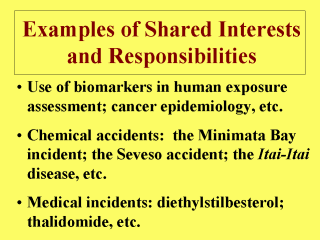 |
Use of biomarkers in human exposure assessment and molecular epidemiology are further examples illustrating the interests and responsibilities shared by some epidemiologists and toxicologists. Advantages of using biomarkers of exposure in epidemiologic research include the reduction of misclassification of exposure measures and the integration of exposure over time and routes of entry. This type of biomarker data can best be interpreted through use of some PB-PK type models which are designed to treat the body as a series of tissue compartments, across which a chemical absorbed, distributed, metabolized, and excreted in accord with PK rate laws. This type of modeling thus will yield a more accurate estimate of the absorbed or internal dose in question.
Other more concrete examples include several major chemical and medical incidents occurring in the not too ancient past. The incident that involved the release of dioxin-containing materials from the Icmesa chemical plant near Seveso, Italy is one good example. The mercury poisoning in Minimata Bay, Japan is another. Still another example is the incident of cadmium poisoning in the Jintsu River Valley, Japan that resulted in victims afflicted by the
Itai, Itai (ouch, ouch) disease. Both diethylstilbesterol and thalidomide are prescription drugs as well as well known teratogens related to two illness episodes. All of these chemical and medical incidents, and many others, involved both epidemiologic investigations and toxicologic elucidation or confirmation in some form, a process whose success hinges upon the expertise of the professionals working in both of these disciplines.
|
